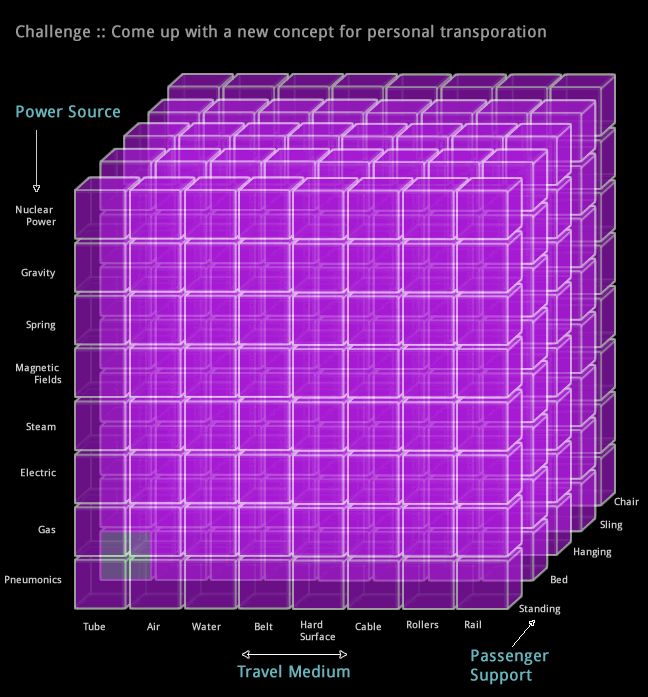iDeAZing
iDeAZing is a creativity tool. It’s based on the premise that many “new” ideas are actually innovative combinations of existing options. The approach we’ve automated is a technique called morphological analysis.
An example of problem solving with this method, taken from the book “Source Book for Creative Thinking,” was to come up with a new form of personal transportation. In the example, three “dimensions” of importance to the problem were selected: the motive of travel, the medium of travel and how passengers were carried. Since this was a pen and paper exercise, and they didn’t have access to the iDeAZing gizmo, three was about the limit to effectively visualize. Next, options for each of these dimensions were listed as you see in the diagram.

You’ll notice that each box represents an intersection of three ideas. So, a steam driven apparatus that runs on rails where you sit in a chair seems to already be taken. A train. The electric motor, cable, sling could be a ski-lift. But what about pneumonic, bed, tube? Could people climb into a cannister, like the kind used in drive up banks, and zip across the country while they caught some z’s?
iDeaZing handles more than three dimensions, then it lets you surf through the idea-space generated. To enter a dimension, type it in the input box on the left (under the Dimension column) and press the enter key. Enter as many dimensions as apply (and maybe throw in a few that don’t.) Next, select one of the dimensions in the Dimension column with your mouse and start entering options for it in the text field under the Option column. Press the enter key after each option. You’ll need to have at least one option for each dimension you enter to generate ideas. The more options input, the more ideas produced.
As you enter options, you’ll get feedback on how many possible intersections of ideas are possible. Click “Generate Ideas” to dive into them. You can always come back to Dimensions and Options to add more and build even wilder ideas. It may take a few days to explore all the ideas you generate, so you can save and restore your session to explore and extend at your leisure.
Tip: After entering a few Dimensions you can tab over to the Options field and the first dimension entered will be auto-selected. As you are entering options, you can also use the up and down arrows to change Dimension selections.
iDeAZing is currently being tweaked. It should appear back here shortly
The Art of Generating Ideas
iDeAZing can assist in exploring novel ideas in almost any arena; your creativity in defining the dimensions for ideas will be amplified in the combinations presented back. Here’s a sample to kick-start your imagination. Share some dimensions you explore as well, in our contact or comments.
Example: Ideas for a Story
So using some generic dimensions for a story including a main character, setting, strange devices and plot twists. Here are a couple of sure fire best sellers that popped up in the generated ideas:
- A Zombie visiting a bordello discovers a mysterious watch which propels one through time based on intention, but he has ADD and it short circuits the watch which sticks him in a perpetual existence one day behind the rest the world
- A Vampire hits an Absinthe bar after losing his job over an embarrassing YouTube incident involving an exploding sheep.
and approximately 8,820 more to look at later.
Thinking Unpredictably
Geniuses are said to form more novel combinations of ideas than the merely talented. Einstein didn’t invent energy, mass or the speed of light, but relating the three together became one of the most famous formulas of our time. Gutenberg mashed the concepts of the wine press and punching coins together to produce moveable type (the apparatus, not the blogging software.) Fred Smith combined the ideas of messenger services, discounted jets for sale and empty skies at night to create Federal Express.
Almost any innovative idea, service or product out in the wild is generally the combination of dimensions and options that someone connected. They were hidden there all along. And million’s more await someone to trip across the combination and put a stake in it.
Our minds typically think in habituated grooves though, so it’s sometimes difficult to come up with novel synergies out of the blue; it’s easier to think about the broad characteristics of the problem. Something our analytical mind does well. A product is made of some material, has some function, etc. When we think about the options for each of these characteristics the possible combinations start to rapidly exceed what we can hold in our heads. So we take shortcuts. Instead of seeing a rich field of possibilities, we start cutting and pruning options with those that we’re familiar with, just to keep them in our short-term memories.
iDeAZing helps with that. You come up with the building blocks and it hangs onto them for you and shows you more possibilities for their construction than you can imagine. If you identify 5 dimensions with 5 options for each dimension, iDeAZing shows you all 3,125 intersections. If only 10% of these are worth further investigation, you still have 312 new ideas to explore.